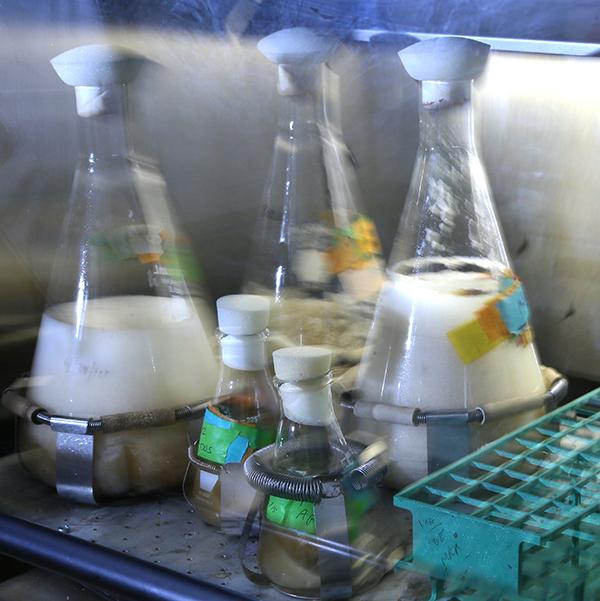

The 'ring' where the bacteria compete is a flask filled with liquid culture media into which two strains of bacteria are added. The flask is then placed on a shake table to ensure the bacteria are continually coming into contact.
Credit: Anne Rayner, Vanderbilt University
That is the conclusion of a team of Vanderbilt chemists who have been exploring ways to get bacteria to produce biologically active chemicals that they normally hold in reserve. These compounds are called secondary metabolites.
They are designed to protect their bacterial host and attack its enemies, so they often have the right kind of activity to serve as the basis for effective new drugs. In fact, many antibiotics and anticancer compounds in clinical use are either secondary metabolites or their derivatives.
In a proof-of-concept test of the fight-club procedure, the research team headed by Associate Professor of Chemistry Brian Bachmann and Stevenson Professor of Chemistry John McLean discovered a promising new class of natural compounds that exhibit anti-cancer activity. The discovery is reported in the article “Mapping microbial response metabolomes for induced natural product discovery” published online by the journal ACS Chemical Biology on June 17.
Bacteria represent a vast untapped reservoir of biologically active compounds. There are an estimated five million trillion trillion bacterial cells on earth. They come in an astounding variety with the best estimate of the number of distinct species ranging from 120,000 to 150,000.
Analysis of microbial genomes has shown that individual bacteria carry the blueprints for hundreds of secondary metabolites. However, biologists have had a hard time either getting bacteria to produce them or synthesizing them directly so they can assess their therapeutic value.
That's where the “fight club” approach comes in. Research associate Dagmara Derewacz came up with the idea of applying the analytical tools the Bachmann and McLean groups had developed to analyze what happens when microbes compete.
“It's a 'shoot first and ask questions later approach,'” said Bachmann, “which is opposite of the traditional approach to natural products drug discovery.”
The first microorganism the scientists put in the ring was Nocardiopsis, a bacteria that is found in the soil. They picked this particular strain because when its genome was sequenced it revealed the presence of 20 gene clusters that carry blueprints for making secondary metabolites.
In order to stimulate the bacteria to produce some of these novel compounds the researchers matched it with four challengers: the common gut organism Escherichia coli; Bacillus subtilis, a well-studied model organism; Tsukamurella pulmonis, which infects people with compromised immune systems; and, Rhodococcus wratislaviensis, which degrades hydrocarbons.
The researchers “co-cultured” Nocoardiopsis separately with each of the challenger microorganisms.
“What Brett Covington in my lab found and quantified was that in every case that the product – the co-culture – was more than the sum of the two monocultures,” said Bachmann. “The co-cultures contained significantly more kinds of biological molecules than the two monocultures combined.”
The researchers were able to make this determination because of an advanced analytical chemistry technique capable of simultaneously identifying thousands of different biological compounds, which McLean and colleagues have helped pioneer. This technology, called ion mobility-mass spectrometry, combines ion mobility spectroscopy that separates and identifies electrically charged molecules by the speed with which they travel through a gas-filled column with mass spectrometry that precisely “weighs” individual molecules by how quickly they travel a given distance in the absence of gas.
The chemists estimate that the cell co-cultures contain somewhere between 20,000 to 50,000 different kinds of molecules. Ion mobility – mass spectroscopy separates these molecules based on their size-to-weight ratio, which naturally sorts them into different regions that correspond to proteins, lipids, sugars, metabolites etc., and allows them to identify about 2,500 metabolites in each co-culture.
One of the biggest technical challenges stems from the wide range in concentrations of different molecules: the bacteria produce some compounds by the dozens but make others by the billions.
The secondary metabolites that the researchers were looking for are generally present in relatively low concentrations, so they had to come up with a method that helped them identify these compounds based on their qualities not their quantities.
They call the method they developed “self-organizing metabolomics maps” or SOM. “SOM is similar to the process Amazon uses to make recommendations for the products they sell,” said McLean.
Amazon monitors your Internet page views, your purchasing history and other information they have about you and make a pattern out of the data. It puts your pattern on a tile and does the same for its millions of other customers. Next, it shuffles these tiles around until neighboring tiles share the most similar patterns. Then they recommend your last purchase to your neighbors and their last purchases to you.
“The SOMs we are using here do much the same thing. They take the patterns in the data we have about all these molecules and match those that behave similarly,” said McLean.
This procedure allowed the chemists to discover a new member of a class of biomolecules with broad ranging activity produced when Nocoardiopsis comes into contact with Rhodococcus wratislaviensis. The scientists named this new compound ciromicin, after a Latin word meaning war/cite/disturb/invoke. Circomicn's structure is similar to that of several FDA-approved antibiotics. The new compound has demonstrated both anti-tumor activity in vitro and the capability to modulate genes involved in programmed cell death.
“In the past, we've experimented with a number of ways to get bacteria to produce their secondary metabolites, including poisoning them with antibiotics and exposing them to rare earths, but the fight club approach is the most effective method we've found, by far,” said McLean.
###
The research was supported by National Institutes of Health grants GM092218 and T32 GM 0650086. Visit Research News @ Vanderbilt for more research news from Vanderbilt.












